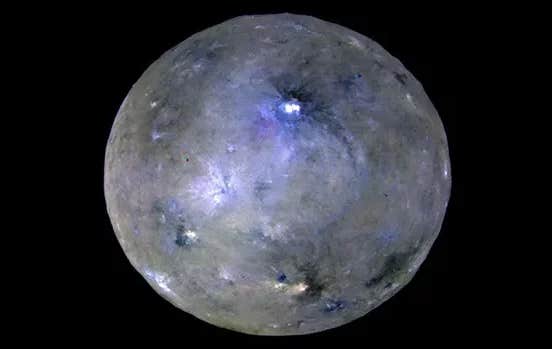Dwarf planet near Earth has 90% water on its surface
New research reveals Ceres was once a muddy ocean world, challenging old theories. Ice-rich crust hints at frozen ocean beneath its surface.

The team behind this work believes that Ceres is much icier than previously thought. (CREDIT: CC BY-SA 3.0)
Astronomers have been curious about the makeup of Ceres, the largest object in the asteroid belt, ever since its discovery by Giuseppe Piazzi in 1801. Ceres, with its heavily cratered and dimpled surface, appeared to be a dry, rocky body.
Previous observations suggested that Ceres was less than 30% ice, and its craters were thought to imply that the dwarf planet was too rocky to have significant amounts of ice. However, recent discoveries suggest that this view might need a major revision.
New research from Purdue University and NASA’s Jet Propulsion Laboratory (JPL) challenges the old assumptions. The team behind this work believes that Ceres is much icier than previously thought, potentially as much as 90% ice. They also propose that Ceres may have once been a muddy ocean world.
This theory comes from the work of Ian Pamerleau, a PhD student, and Mike Sori, assistant professor in Purdue’s Department of Earth, Atmospheric, and Planetary Sciences. Their findings were published in Nature Astronomy and suggest a dirty ice crust, formed as the planet’s muddy ocean froze over time.
According to Mike Sori, “We think that there's lots of water-ice near Ceres surface, and that it gets gradually less icy as you go deeper and deeper." He explained that earlier theories suggested that if Ceres had a high ice content, its craters would have deformed quickly, behaving like glaciers on Earth or a viscous substance like honey. However, their simulations show that ice mixed with a small amount of solid rock can be much stronger, causing craters to remain stable over billions of years.
These computer simulations, led by Pamerleau and Sori, modeled how Ceres’ craters have changed over time. As Pamerleau explains, “Even solids will flow over long timescales, and ice flows more readily than rock. Craters have deep bowls which produce high stresses that then relax to a lower stress state, resulting in a shallower bowl via solid state flow."
Related Stories
He pointed out that NASA’s Dawn mission had originally concluded that Ceres couldn’t be very icy, due to the lack of shallow craters. However, their new simulations account for how a mixture of ice and rock might cause a rich ice crust to flow so slowly that the craters don’t appear to change much over billions of years.
The researchers found that the best explanation for the lack of crater relaxation was a gradational crust, where a high concentration of ice exists near the surface, gradually decreasing with depth. This structure would prevent significant deformation, preserving the deep craters seen today. The findings also support the idea that Ceres was once an ocean world, similar to Jupiter's moon Europa or Saturn’s moon Enceladus, but with a dirtier, muddier composition.
Sori emphasizes how this discovery could reshape our understanding of icy bodies in the solar system. He noted, "Ceres is the largest object in the asteroid belt, and a dwarf planet. I think sometimes people think of small, lumpy things as asteroids (and most of them are!), but Ceres really looks more like a planet." Ceres has a diameter of around 950 kilometers and features common to larger planetary bodies, such as craters, volcanoes, and landslides.
The discovery builds on data from NASA’s Dawn mission, which orbited both Ceres and the protoplanet Vesta. Dawn was launched in 2007 and reached Ceres in 2015, continuing to orbit the dwarf planet until the mission ended in 2018. The spacecraft provided crucial data that helped the researchers refine their models of Ceres' surface and interior.
"We used multiple observations made with Dawn data as motivation for finding an ice-rich crust that resisted crater relaxation on Ceres," said Pamerleau. Features like pits, domes, and landslides on Ceres’ surface point to the presence of ice near the subsurface. Spectrographic data from Dawn also indicated ice beneath Ceres' regolith, and gravity data showed a density close to that of impure ice. The researchers even took topographic profiles of craters to model their simulations more accurately.
Sori remarked on the significance of Ceres as a target for planetary exploration. As the largest asteroid and a potential ocean world, Ceres was a compelling candidate for a spacecraft mission. Its proximity to Earth and unique composition make it a valuable point of comparison to the ocean-hosting moons of the outer solar system, like Europa and Enceladus.
"To me the exciting part of all this, if we're right, is that we have a frozen ocean world pretty close to Earth," Sori said. "Ceres may be a valuable point of comparison for the ocean-hosting icy moons of the outer solar system, like Jupiter's moon Europa and Saturn's moon Enceladus. Ceres, we think, is therefore the most accessible icy world in the universe. That makes it a great target for future spacecraft missions."
The bright features on Ceres’ surface are thought to be remnants of its frozen ocean, now mostly or entirely frozen solid and erupted onto the surface. These regions could provide valuable material for future missions to collect samples from an ancient ocean world. As Sori puts it, "We have a place to collect samples from the ocean of an ancient ocean world that is not too difficult to send a spacecraft to."
This research opens up new possibilities for exploring Ceres and other icy bodies in the solar system, offering insights into the history of these distant worlds and their potential to host oceans beneath their surfaces.
Note: Materials provided above by The Brighter Side of News. Content may be edited for style and length.
Like these kind of feel good stories? Get The Brighter Side of News' newsletter.
Rebecca Shavit
Science & Technology Journalist | Innovation Storyteller
Based in Los Angeles, Rebecca Shavit is a dedicated science and technology journalist who writes for The Brighter Side of News, an online publication committed to highlighting positive and transformative stories from around the world. With a passion for uncovering groundbreaking discoveries and innovations, she brings to light the scientific advancements shaping a better future. Her reporting spans a wide range of topics, from cutting-edge medical breakthroughs and artificial intelligence to green technology and space exploration. With a keen ability to translate complex concepts into engaging and accessible stories, she makes science and innovation relatable to a broad audience.



